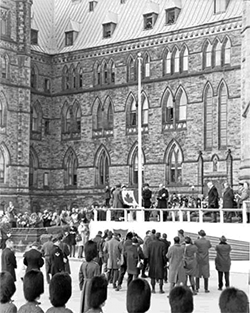Helping to make the first Canadian flag
On July 1, 2017, the nation’s capital will inspire a sea of people wearing the colours of our magnificent flag to join together and celebrate the 150th anniversary of Confederation.
In this “Celebrating Public Services and Procurement Canada’s history” story, learn the history of the flag and how Public Services and Procurement Canada helped to make the very first maple leaf flag.
The search for a flag
In 1964, the centennial anniversary of Canada’s confederation was fast approaching. Prime Minister Lester B. Pearson’s government formed a Senate and House of Commons Committee to find a distinctive national flag. At the time, the Royal Union Flag (or Union Jack) was the official National Flag of Canada.
From about 5,900 submissions, 3 proposed designs were selected for final consideration.
Explore the proposed designs for the new flag
Prime Minister Pearson preferred Alan Beddoe's flag. The design, which featured 3 red maple leaves and 2 blue borders, was nicknamed the Pearson Pennant.
Public Services and Procurement Canada lends a hand
One Friday afternoon, in the late autumn of 1964, an urgent request came from the Prime Minister to the desk of Ken Donovan. Donovan was an assistant purchasing director with the Canadian Government Exhibition Commission (which later became a part of Supply and Services Canada, one of Public Services and Procurement Canada’s predecessors). The Prime Minister wanted prototypes of the 3 proposals to try out the next morning at his new Harrington Lake residence.
The only samples they had of the designs were drawings on paper. Donovan and his team of designers had to create the flag prototypes in just one evening. Graphic artists and silk screeners Jean Desrosiers and John Williams were called in. Since no tailor could be found, Donovan's 20-year-old daughter, Joan O’Malley, stitched the flags together.
During a ceremony celebrating the 30th anniversary of the flag, O’Malley recounted her experience:
"I really didn't realize what I was getting into when I got that phone call from my father in 1964. I was just doing my father a favour, not participating in history. Let me tell you, I don't think of myself as the Betsy Ross type.
And sewing the flag was not easy. I was no professional; I had just sewed some of my clothes before this. My sewing machine wasn't made for such heavy material. But eventually, the flag came together.
At the time, it wasn't the best way I could think of to spend a Friday night. In fact, my father was more excited than I was about the whole thing. He was the one who got to deliver the prototypes to Mr. Pearson's house.
Even though I may not have realized the importance of what I had been asked to do then, I felt good about sewing the prototypes for the flag. It was certainly not a request people got every day."

The red and white maple leaf flag is raised for the first time on Parliament Hill, February 15, 1965.
Source: The Gazette, Montreal / Library and Archives Canada / PA-117488
A flag is chosen
Of the 3 prototypes, Dr. George Stanley’s red and white maple leaf design was chosen.
On February 15, 1965, our national flag was raised for the first time on Parliament Hill.
Within weeks of the flag's debut in 1965, the colours in flags were fading, the red parts were “bleeding” into the white, and then some turned from red to pink to orange. Something had to be done. Standards were needed!
Over the next few months, Public Services and Procurement Canada’s Canadian General Standards Board developed a standard for the flag. The department published standards for the National Flag of Canada, 98-GP-1, on June 1, 1966.
Learn more about the standards for our national flag
How Public Services and Procurement Canada keeps the flag flying
The Canadian General Standards Board continues to develop and maintain requirements for how the National Flag of Canada is made. The standards include requirements for the design, colour, fabric, construction and performance for the flag. The materials used to produce a Canadian flag were even tested in a wind tunnel to make sure they can hold up to the rigors of our climate.
Public Services and Procurement Canada takes care of the flags on Parliament Hill. Every weekday, the department’s flag master changes the Peace Tower flag. The other flags on Parliament Hill are changed weekly.
Meet the flag master or request your own Parliament Hill flag
The department has an events and conference management group, which is part of its real property services. The group helps government departments and agencies organize events and conferences. The group has hundreds of Canadian flags it uses to display for events. It also carries an inventory of flags of all countries with which Canada has diplomatic relations.
More information
History of the National Flag of Canada
Now that you’ve read the story, test your knowledge by taking our quiz.
- Date modified: